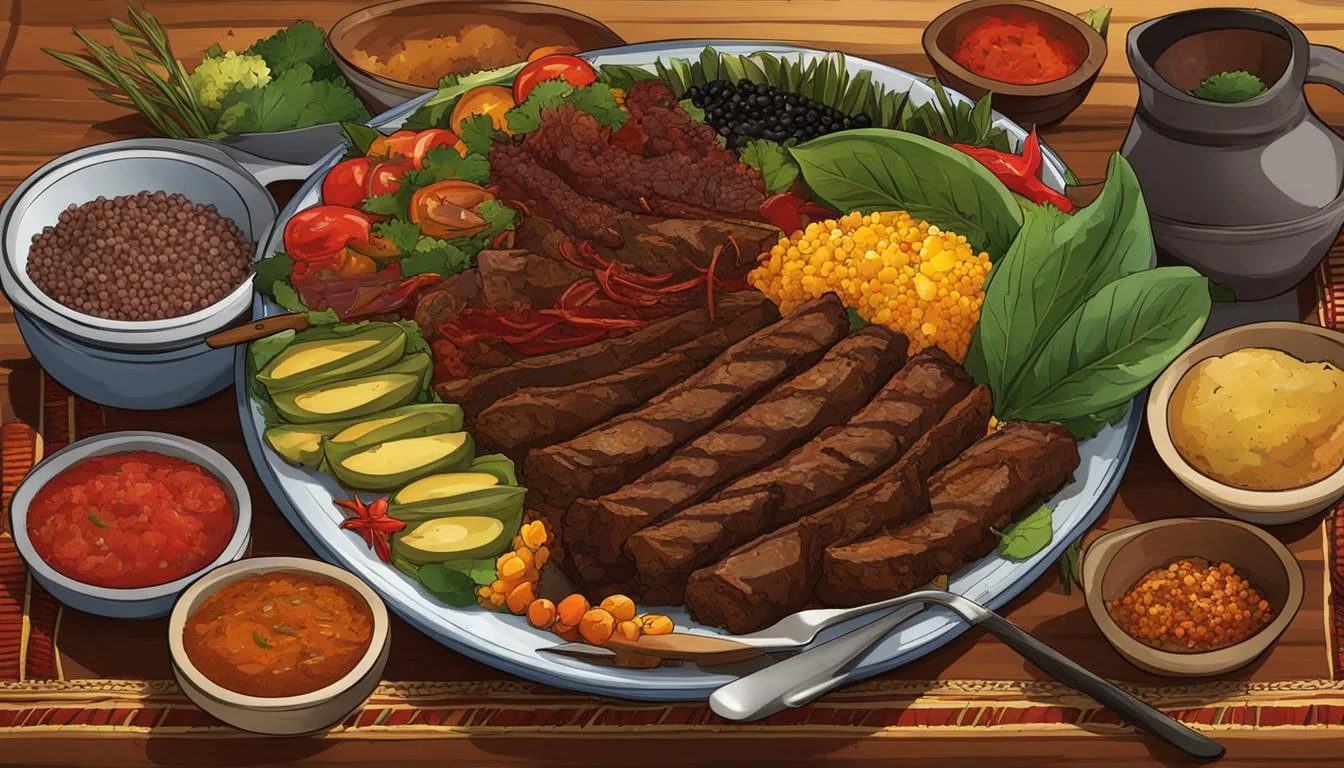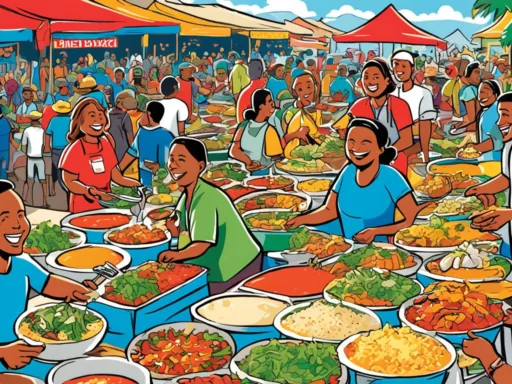Rich in diversity and flavor, Uganda remains an undiscovered gem in the world of gastronomy. Much like its vibrant culture, Ugandan cuisine is a colorful mosaic of tastes that many have yet to savor. With traditional Ugandan recipes making more than just a meal, they serve a story of history, community, and nature. This Ugandan Cuisine Guide is an invitation to discover the authentic, delectable Ugandan dishes that capture the essence of this warm African nation. From the nourishing matooke to the delightful street-side rolex, Uganda’s food scene is a journey worth taking.
Key Takeaways
- Understand the integral role of local produce in Uganda’s food identity.
- Explore the simplicity and richness embodied in staple Ugandan dishes.
- Uncover the surprising variety within Ugandan street food.
- Appreciate the social and historical influences that shape traditional Ugandan recipes.
- Discover how traditional methods of cooking contribute to the unique tastes of Ugandan dishes.
The Melting Pot of Ugandan Culinary Culture
Within the heartland of East Africa, the Ugandan culinary culture is an exquisite example of harmony in diversity. With a rich tableau of ethnic communities, from the Buganda tribe in the central region to the Acholi peoples of the north and the Bakiga in the southwest, each group weaves its own thread into the vibrant fabric that is traditional Ugandan cuisine.
These cultural influences on Ugandan cuisine are deeply ingrained and reflected in the array of traditional Ugandan meals. A unifying theme across this diversity is a strong reliance on the fresh bounty of the land, with locally sourced ingredients forming the cornerstone of meals that are deceptively simple yet wildly transcendent. Indeed, the essence of Ugandan food lies in its ability to mirror the nation’s eclectic historical tapestry—spoonful by soulful spoonful.
- Central Uganda boasts generous use of plantains and the famous matooke dish, a testament to the agricultural affluence of the region.
- In the North, the Acholi and Langi peoples often celebrate their cattle rearing heritage with rich, hearty stews.
- The West, which includes the Bakiga, emphasizes robust, highland-grown ingredients within their culinary creations.
It’s in these everyday eatings that one finds the most poignant reminders of Uganda’s story—a story not just of food, but of identity, history, and the communal harmony that bellies full of carefully prepared dishes can bring.
At the center of Ugandan cuisine is a communal table where survival food fares of the past now flourish as dishes of cultural pride and culinary delights. Bringing everyone together, these meals are savored as much for their taste as for the unity they foster.
This melting pot of flavors maintains its heat through the shared experiences of meals. Each dish bears the signature of its origin—be it the nomadic necessity that gave rise to the widely loved luwombo stew or the agricultural adaptions evident in the everyday excellence of posho cornmeal. Ugandan culinary culture is thus firmly planted in its people’s diversity, providing an endlessly rich menu for both locals and visitors alike to explore.
A Discovery of Ugandan Staple Foods
Uganda’s gastronomic landscape is adorned with an array of staple dishes that are not just sustenance, but a celebration of the nation’s rich culinary heritage. Among these, traditional Ugandan recipes featuring matooke and posho stand out for their vital roles in everyday diets, festivities, and as emblems of cultural identity. Below, we delve into the significance and preparation of these ubiquitous dishes.

Matooke: The Ubiquitous Delight
In the realm of staple Ugandan dishes, matooke is a testament to the country’s agricultural bounty and culinary inventiveness. Originating from green bananas, this staple is a versatile component of traditional Ugandan recipes. It is commonly served steamed and mashed, forming a comforting base for a variety of rich stews and succulent sauces that capture the essence of Uganda’s traditional cuisine.
Posho: Sustenance in Simplicity
When simplicity meets nutrition, posho emerges as a dietary mainstay across Uganda. This smooth cornmeal porridge is made from finely ground maize, epitomizing the nurturing spirit of Ugandan fare. Posho’s subtle flavor and hearty texture make it an ideal accompaniment to beans, meat, or the revered groundnut sauce, creating a harmonious meal that speaks to the resilience of the Ugandan spirit.
| Staple Dish | Main Ingredient | Cooking Method | Common Pairings | Cultural Significance |
|---|---|---|---|---|
| Matooke | Green bananas | Steamed and mashed | Stews, groundnut sauce | Serves as a symbol of shared identity |
| Posho | Maize flour | Boiled to a porridge | Beans, meat dishes | Represents sustainability and comfort |
Ugandan Street Food: A Taste of the Local Life
Uganda’s vibrant street food scene is a flavorful showcase of the nation’s innovation and cultural fusion. At the heart of this scene is the rolex, Uganda’s signature street food delight known for its savory, eggy interior, all wrapped in a soft, golden-brown chapati. With every bite, food enthusiasts experience the harmony of popular Ugandan ingredients coming together to deliver a handheld meal that’s both satisfying and quintessentially Ugandan.
Another staple of Ugandan street food is the mandazi, a puffy and slightly sweet treat that complements the country’s robust teas, providing a balance of flavors that locals and visitors alike relish. Both the rolex and mandazi are not just quick eats but represent the essence of Ugandan innovation, offering a glimpse into everyday life through the country’s culinary traditions.
| Street Food | Ingredients | Flavor Profile | Eating Occasion |
|---|---|---|---|
| Rolex | Eggs, chapati, vegetables, optional meats | Savory with a hint of spice | Any time, especially breakfast or lunch |
| Mandazi | Flour, sugar, coconut milk, yeast | Sweet and airy | Snack, typically with tea or coffee |
The allure of Ugandan street food lies not just in its flavors but also in its accessibility. Street corners and markets paint a bustling canvas where locals mingle and snack, giving visitors an authentic taste of Uganda. Whether it’s a quick rolex on-the-go or a mandazi during a leisurely evening, each bite is an introduction to the pulse of the country’s food scene.
Savoring the Richness of Ugandan Meat and Fish Dishes
Within Uganda’s vibrant cultural tapestry, its meat and fish dishes are particularly noteworthy, standing out for their flavorful complexity and traditional preparation techniques. These savory dishes not only satisfy the palate but also reflect the unique culinary heritage of the nation.
Luwombo: A Packaging of Flavors
The celebrated luwombo is a testament to Ugandan cooking techniques that have been perfected over time. This dish involves tenderizing various meats or fish by marinating them with a mix of flavorful spices and then meticulously wrapping and steaming them inside banana leaves. The result is a potently aromatic and succulent dish that is both a delight to the senses and a nod to the ingenuity of Ugandan cuisine.
Tilapia: Fresh from Uganda’s Waters
Uganda’s abundant lakes and rivers bless its cuisine with a bounty of freshwater fish, with tilapia taking a place of honor on the Ugandan table. When this cherished fish is prepared with a rich groundnut sauce, it captures the essence of Ugandan fish dishes—fresh, wholesome, and deeply satisfying.
| Ingredient | Luwombo | Tilapia Dish |
|---|---|---|
| Protein Source | Beef, Chicken or Fish | Fresh Tilapia |
| Cooking Method | Steamed in Banana Leaves | Grilled or Fried |
| Spices | Traditional Blend | Chili, Garlic, Ginger |
| Sauce | Groundnut or Tomato-Based | Groundnut Sauce |
Both luwombo and tilapia dishes serve as prime examples of the savory meat and fish selections found within Uganda’s culinary repertoire. They showcase a balance between tender, well-seasoned protein and the potent flavors of sauces that are beloved across the country. Indeed, to taste these dishes is to embark on an exquisite journey through the heart of Ugandan gastronomic culture.
Vegetarian’s Delight: Healthy Eats in Uganda’s Cuisine
Within the colorful palette of Uganda’s culinary spectrum, vegetarian dishes stand out for their vibrancy and healthful qualities, reflecting the nation’s commitment to sustainable eating. For those who savor plant-based meals, Ugandan cuisine offers an array of vegetarian recipes featuring homegrown vegetables and legumes, rich in nutrients and flavors. Dishes like nakati sautéed with spices, and matoke paired with peanut sauce, are not only staples of vegetarian Ugandan cuisine but also beloved examples of healthy Ugandan dishes that cater to locals and visitors alike.

Nakati and Groundnuts: The Green Plate Special
The dish of sautéed nakati leaves combined with the nutty richness of groundnuts creates a symphony of taste that is both nourishing and deeply satisfying. Nakati, hailing from the rich soils of Uganda, forms the backbone of several vegetarian recipes, delivering not just essential vitamins but also a burst of local flavor that makes Ugandan dishes distinctly bold and memorable.
The Matoke and Peanut Sauce Union
Matoke, a type of cooking banana indigenous to the region, provides a comforting base for many Ugandan meals. When harmoniously blended with a savory peanut sauce, it transforms ordinary vegetarian fare into a heartwarming dish that rivals any meat-based counterpart in complexity and comfort.
| Dish | Key Ingredients | Health Benefits |
|---|---|---|
| Nakati with Groundnuts | Nakati leaves, groundnuts, onions, tomatoes, spices | Rich in fiber, protein, vitamins A and C |
| Matoke with Peanut Sauce | Matoke bananas, peanut sauce, garlic, onions | High in potassium, complex carbohydrates, and healthy fats |
As more people globally turn to vegetarianism for health and ethical reasons, Ugandan chefs are proving that their time-honored recipes are adaptable and relevant. These healthy Ugandan dishes not only cater to the vegetarian palate but also extend a warm invitation to all food lovers to indulge in the rich and diverse vegetarian Ugandan cuisine.
Unraveling Traditional Ugandan Cooking Techniques
The essence of traditional Ugandan cooking methods is found not just in the flavorsome outcomes but also in the cultural stories each dish carries. Authentic Ugandan meals are much more than sustenance; they are a testament to Uganda’s rich culinary heritage, embodied through roasting, steaming, and slow-cooking.
One of the prime examples of these cooking methods is luwombo, a revered dish that encapsulates the essence of communal cooking. Matoke, another staple, gains its distinctive taste through the steaming process within banana leaves, which infuses it with a subtle, earthy aroma.

Rituals around meal preparations are as important as the meal itself, often transforming cooking into a collective experience where stories and techniques are passed down through generations. Below is an overview that highlights the core techniques that make Ugandan cuisine a rich tapestry of tastes and traditions. This insight into traditional Ugandan cooking methods enables a deeper appreciation for the authenticity of Ugandan gastronomy.
| Technique | Dishes | Ingredients |
|---|---|---|
| Roasting | Nyama Choma (Grilled Meat) | Meat, Salt, Chili |
| Steaming | Matoke (Steamed Bananas) | Green Bananas, Tomato, Onion, Garlic |
| Slow-Cooking | Luwombo (Stewed Dish) | Chicken, Beef, or Fish, Vegetables, Peanut Sauce |
The preservation of these authentic Ugandan meals and their respective techniques are crucial, not just for their delightful flavors but also for their cultural significance. As we unravel these time-honored cooking methods, we not only discover the soul of Ugandan cuisine but also the communal bonds that these practices strengthen.
Ugandan Cuisine Guide: Navigating the Flavors of a Nation
Embark on a tantalizing journey through the robust flavors and rich traditions of Ugandan cuisine. This guide serves as an indispensable companion for food aficionados aiming to savor the authentic tapestry of tastes this East African gem has to offer. From bustling marketplaces with their fragrant spices to the warm hospitality found in local eateries, every bite tells a story of Uganda’s bountiful heritage.
Must-Try Ugandan Dishes for the Avid Foodie
Uganda’s culinary landscape is vast, with dishes that promise to charm the palate of any curious gourmet. Staples like the versatile matooke, a savory banana delicacy, and the comforting posho, a maize meal, form the foundation of the Ugandan diet. The celebrated rolex, not a watch but an inviting street food, brings together chapati and eggs in delightful harmony, demonstrating the creativity that typifies Ugandan street cuisine.
Exploring Uganda’s Best Culinary Experiences
To truly appreciate the gastronomy of Uganda, one must dive into the various culinary experiences that offer a window into the soul of Ugandan traditions. Engaging food safaris and cooking tours provide both context and connection to the popular Ugandan ingredients that are the cornerstones of local recipes. These experiential outings rank among the best culinary experiences in Uganda, inviting participants to relish in the hands-on preparation of traditional dishes, all while absorbing the historical narratives that flavor each meal.
Consolidating one’s understanding of this rich food culture, the table below highlights a selection of iconic Ugandan dishes that are integral for any gastronome’s foray into Ugandan cuisine:
| Dish | Main Ingredients | Flavor Profile | Origin |
|---|---|---|---|
| Rolex | Chapati, eggs, vegetables | Savory with a hint of spice | Street food favorite |
| Matooke | Green bananas, lemon juice, tomatoes | Earthy sweetness | Central and Western regions |
| Posho | Cornmeal, water | Mild and doughy | Staple dish nationwide |
| Groundnut Stew | Groundnuts, chicken or beef, spices | Rich and nutty | Traditional Luganda cuisine |
By exploring the medley of Ugandan cuisine, including its tradition-steeped dishes and the Ugandan Cuisine Guide, food lovers can embark on an unparalleled culinary adventure, celebrating the unique and enduring spirit of Uganda through every last morsel.
Best Ugandan Restaurants: Where Tradition Meets Contemporary
As the landscape of Kampala’s gastronomy expands, the interplay between authentic Ugandan heritage and modern culinary techniques has given rise to some of the best Ugandan restaurants. Diners seeking the full spectrum of traditional Ugandan meals and refreshing, modern interpretations will find themselves spoilt for choice in the vibrant city.
Authentic Ugandan Meals in the Capital, Kampala
Kampala dining experiences are a testament to the city’s dedication to cultural authenticity and culinary innovation. Renowned for its resourceful use of the rich local produce, the city’s dining establishments serve as gatekeepers of tradition while embracing contemporary influence. The following table outlines some standout dishes and where they can be enjoyed in Kampala:
| Dish | Description | Restaurant | Ambiance |
|---|---|---|---|
| Luwombo | Traditional stew steamed in banana leaves | Olives Restaurant | Warm, Elegant |
| Matooke | Mashed plantains typical of Ugandan cuisine | Emmere Ya Uganda | Authentic, Homely |
| Nsenene | Seasonal delicacy of pan-fried grasshoppers | The Lawns | Adventurous, Open-Air |
| Rolex | Chapati wrap filled with eggs and vegetables | Mama Ashanti | Lively, Colorful |
Each of these establishments not only offers a signature approach to time-honored dishes but also an engaging atmosphere that contributes to the overall dining experience.
Fine Dining with a Ugandan Twist
The growing trend of fine dining with a Ugandan twist caters to food enthusiasts seeking both familiarity and surprise. The fusion of local ingredients with international techniques has resulted in a luxurious wave of new tastes. Some of Kampala’s high-end spots include:
- Tamarai Thai Restaurant: Offering a Thai-Ugandan fusion menu that highlights the versatility of Ugandan produce.
- La Patisserie: A European-style bistro with unique Ugandan-inspired pastries and desserts.
- The Bistro: Known for incorporating Ugandan flavors into continental dishes, creating a cosmopolitan tasting affair.
In the thriving capital city of Uganda, every patron can embark on a journey where the best Ugandan restaurants provide not just a meal, but a narrative—a symphony of flavors commemorating the past while flirting with the future.
A Delectable Tour: Popular Ugandan Ingredients in the Spotlight
Embarking on a culinary journey through Uganda, one is sure to encounter a vast array of popular Ugandan ingredients that are central to the traditional and evolving Ugandan food culture. From the staple crops that sustain communities to the exotic spices that add a zeal of flavor, the ingredients are as diverse as they are flavorful. In the heart of this rich palate lies the essence of what makes the Ugandan dining scene uniquely inviting.
Ingredients such as millet and maize flour serve as the base for various foods, while pulses like groundnuts add both texture and nutritional value. Fruits, notably bananas which are used in the iconic matooke dish, and pineapples bring sweetness and vibrancy to the country’s plate. Spices including curry powder are generously utilized to amplify the depth of flavor in many dishes. Alongside these, freshwater catches like the Nile perch, prepared in a myriad of ways, showcase Uganda’s innovative approach to traditional methods. Below is a table highlighting some of the central ingredients that any food aficionado exploring Uganda should be well-acquainted with:
Table: Key Ugandan Ingredients and Their Utilization
| Ingredient | Description | Common Uses |
|---|---|---|
| Millet Flour | A nutrient-rich cereal grain | Breads, porridges |
| Maize Flour | Finely ground maize kernels | Posho, snack cakes |
| Groundnuts | Legume crop akin to peanuts | Sauces, stews, snacks |
| Bananas | Staple fruit in various stages of ripeness | Steamed (matooke), desserts, snacks |
| Pineapples | Juicy tropical fruit with a bold flavor | Beverages, desserts, side dishes |
| Curry Powder | Spice blend with turmeric, coriander, cumin, and more | Marinades, stews, rice dishes |
| Nile Perch | Large freshwater fish from Ugandan lakes | Grilled, in stews, fried |
The synthesis of these ingredients translates into a multifaceted cuisine that resonates with history, tradition, and a passion for gastronomic innovation. Grounded in the earthiness of grains, the richness of nuts, the sweetness of fruits, and the savoriness of freshly sourced fish and meats, the Ugandan kitchen is a place where every palate can find contentment. As we delve deeper into the popular Ugandan ingredients, it’s evident that Uganda’s culinary tapestry is as much about the combined tastes as it is about the communities and stories behind them.
Conclusion
Embarking on a journey to explore Ugandan dishes invites you to a sumptuous tableau of flavors, each telling its own story of the land’s authentic Ugandan culture. This exploration is not merely about enjoying the diverse culinary offerings—from the omnipresent matoke and hearty posho to the innovative street rolex—but about understanding a culture that prides itself on its hospitality and its rich, culinary heritage. The mélange of traditional recipes passed down through generations and the vibrant energy of contemporary Ugandan kitchens makes for exquisite food travels that are both enlightening and intricately flavorful.
As you navigate through Uganda’s robust food scene, you encounter dishes steeped in tradition and others emerging from inventive twists, all underscored by the country’s commitment to freshness and authenticity. The gastronomic delights that Uganda offers go beyond satiating the palate; they provide a sensory immersion into the daily life and communal spirit that Ugandans cherish deeply. To truly appreciate this culinary diversity, one must not only taste but also partake in the making and sharing of these dishes.
Whether it is feasting on ugali with friends, sipping on spiced tea amidst bustling markets, or reveling in the ambience of a Kampala restaurant that blends the old with the new, Uganda’s culinary journey is sure to leave an indelible mark on your senses. So, we invite gastronomes and adventurers alike to indulge in these rich flavors and woven stories that make Ugandan cuisine a tapestry worth savoring, dish by dish, story by story.






